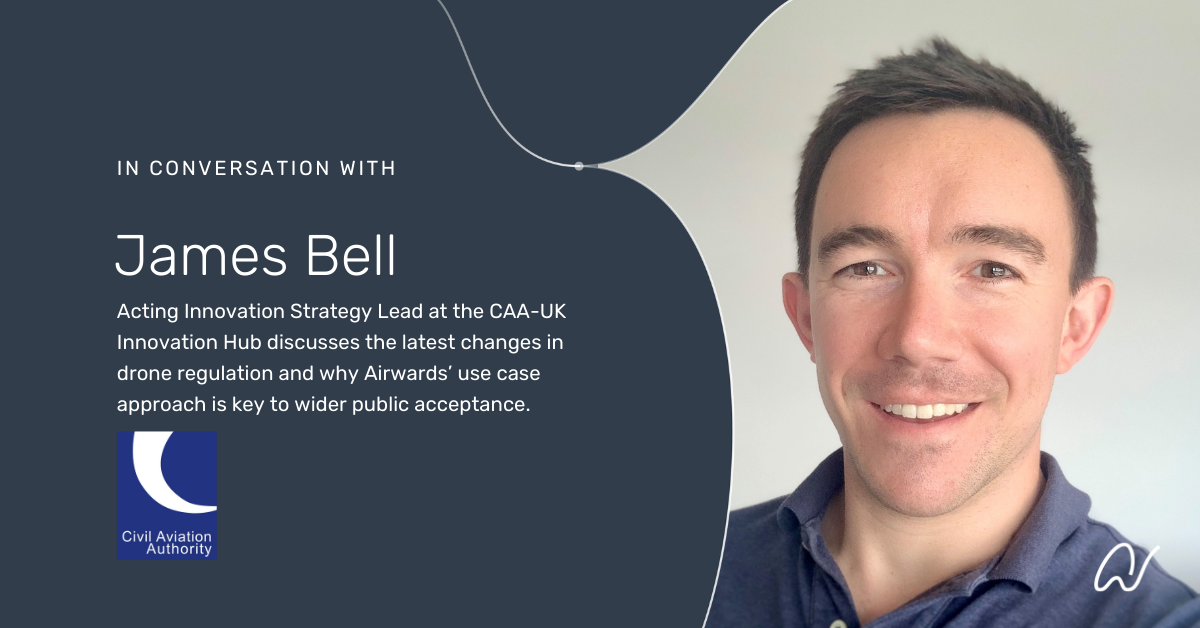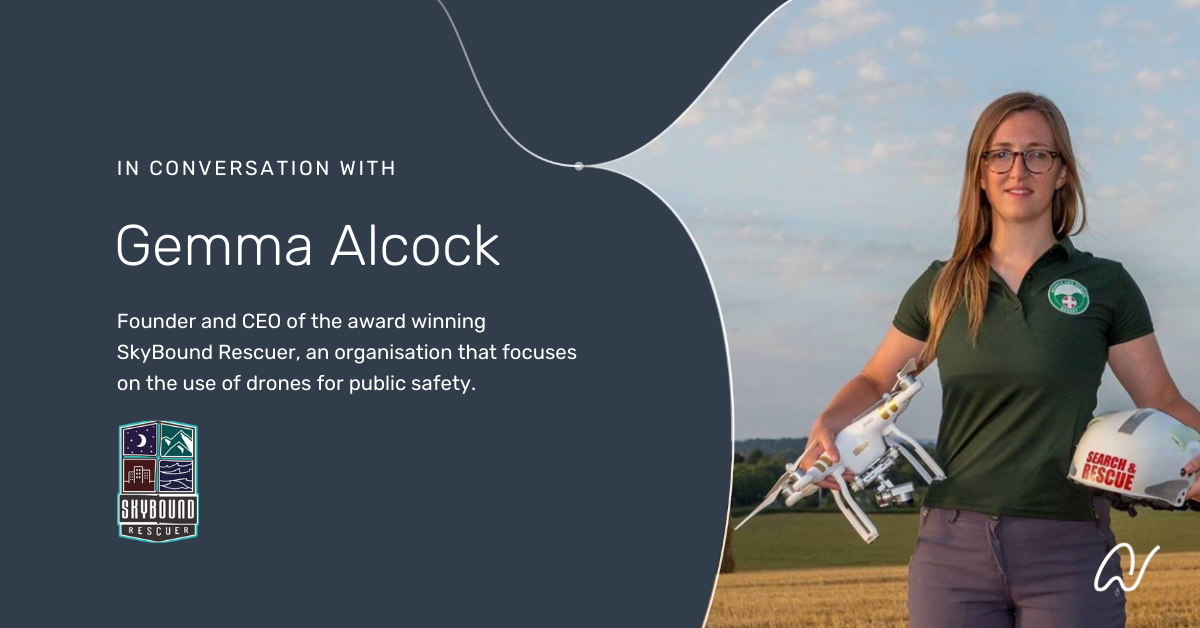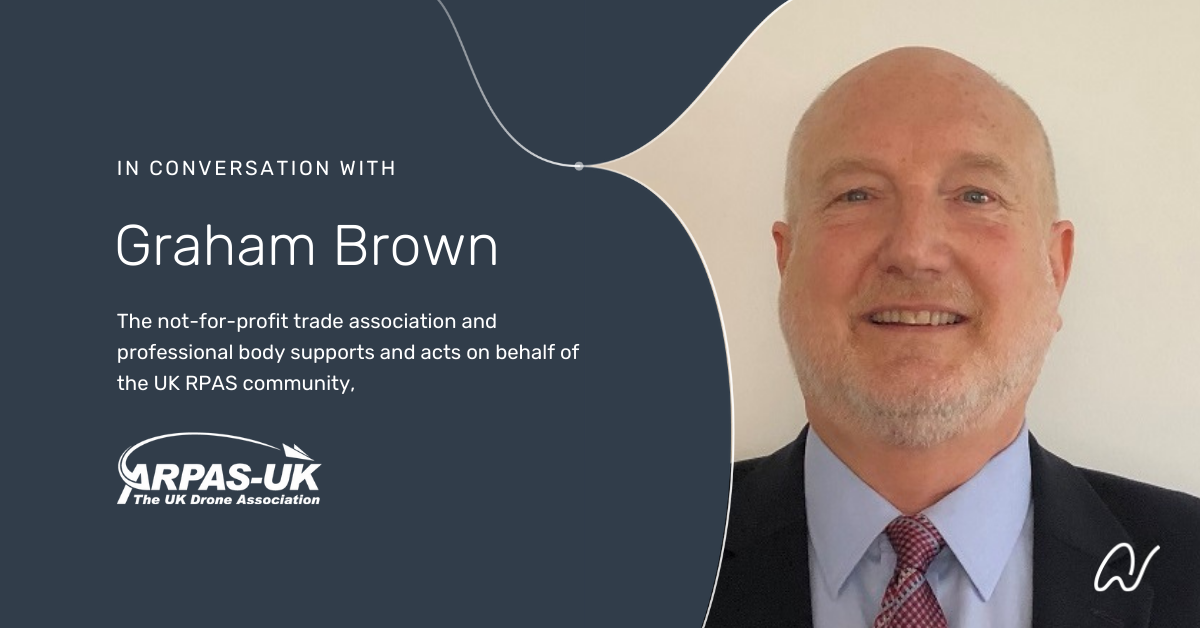In Conversation With
Each week, Airwards chats to someone in the drone industry doing incredible work. We uncover what they do, what makes them tick, where they see the drone industry headed, and discuss positive drone use.
In our latest blog, Airwards chats to Gemma Alcock, Founder and CEO of SkyBound Rescuer. Gemma’s work focuses on the use of drones for public safety. At just 27, Gemma has achieved a huge deal for both the search and rescue (SAR) and drone industries, with numerous awards under her belt to show for it.
Her company, Skybound Rescuer, brings together specialists to research, innovate and educate on drones for public safety, ultimately aiming to enable Emergency Services to use drones to save lives that couldn’t be saved before. In this conversation, we uncover how she founded her company at 22 and what her proudest moments are so far. We also explore some successful use cases of drones in search and rescue - and why an awards programme is just what the drone industry needs right now.
“I truly believe drones are the future, but the drone industry isn’t progressing quite as quickly as everyone thought. An awards programme motivates and validates people’s efforts in the short-term, and inspires others to join - which will ultimately progress the industry, faster.”
1 | How did SkyBound Rescuer come about?
It actually started as my dissertation project seven years ago, when I was studying Design Business Management at Bournemouth University. The brief was to find a problem and solve it with technology. I was a beach lifeguard for the Royal National Lifeboat Institution, so I decided to explore search and rescue.
I soon discovered the RNLI has a problem finding people at sea in darkness. In SAR, we talk about ‘the golden hour’ - that first hour you’ve got to find a missing person and get them to definitive care, to give them the best chance of survival. I learnt that during the hours of 11pm and 8am, Coastguard helicopters take an average of 45 minutes to take off from request. That means most of the time, they are missing that window of best chance survival rate.
So my project became about exploring how I could give all the benefits helicopters provide (better vision and technology on board) - to lifeboat crews, instantly. And that’s when it became about drone technology as a life saving tool for SAR. The project went on to win an award from the Royal Academy of Engineering and emergency services all over the world - from America and Australia - wanted to know about it. After that, I decided to found SkyBound Rescuer to help any SAR service that wanted to explore drone technology.
2 | What examples can you share of drones successfully being used in SAR?
One of the first publicly documented times a life was saved by a drone was over in Australia. Whilst a drone was out on shark patrol, the drone pilot spotted someone struggling in the rip current and was able to drop a lifesaving flotation device.
Right now, all examples like this are still the result of pilot-in-the-loop - i.e. operated manually by the pilot. However, I’m currently working on a ‘drone in a box’ network with Herotech8. This network can be controlled anywhere in the world, and charged automatically on-site. I’m researching a best-case scenario where these boxes could be situated all across the UK, and, with sufficient overlap, could provide full coverage of the country. This means we could task a drone to any point and have an on-scene response time of less than 5 minutes - which is 10 minutes faster than the target for police helicopters and 55 minutes faster than the target for the Coastguard helicopters.
3 | What is the proudest moment in your career so far?
I have played a part in several lifesaving incidents in my beach lifeguarding work but I remember the first one the clearest. I was first on-scene so it was my job to communicate what equipment and assistance was needed, and it was also my job to carry out the rescue. I went into the freezing cold sea (in May!) to rescue someone in just my bikini (there was no time for a wetsuit), and because of my early radio call, the jet ski with two other lifeguards got there rapidly. The team and I then conducted casualty care treatment that brought them back to being alive and breathing.
Throughout the incident, I managed to remain calm and remember my training, which is a huge achievement. You never really know how you are going to react in those situations, despite the continuous training we receive. But it wasn’t until the paramedics arrived on scene and asked me if I was cold that I realised the adrenalin had totally kept me going and I was blue (still in my bikini). It was the most profound feeling, giving someone a second chance of life. It reaffirmed that what motivates me most in life is saving and improving lives.
Visit the SBR store here.
4 | What’s been the most terrifying moment to date?
This has to be overcoming my fear of speaking at the House of Commons. I was asked to talk at a series of science and tech committees that were reviewing changes in air law. It was hands down the scariest thing I’ve done - and I was jet lagged!
The key point I made was advocating ‘education first, regulation second’. Governments often make knee jerk reactions and create regulations to solve a problem, when 9 times out of 10, people have broken the rules because they don’t realise they exist - or don’t understand the importance of sticking to those rules. If there are education campaigns around the rules and why they exist, they’ll have a bigger impact than changing regulations all the time - which is confusing anyway.
5 | What do you think of Airwards and what do you hope it’ll achieve?
An awards scheme is just what the drone industry needs right now! There’s a lot of potential and promise for drones; many companies have given it huge achievement figures in the not-so-distant future. I truly believe drones are the future, but the drone industry isn’t progressing quite as quickly as everyone thought. There are many people currently working incredibly hard to mould this industry and enable it to achieve those future figures. And this can be hard - to keep yourself motivated, when there are little or no short-term benefits and when those goal posts feel like they’re always moving. I think an awards programme motivates and validates people’s efforts in the short-term, and inspires others to join - which will ultimately progress the industry, faster.
From a personal standpoint, winning an award was a turning point in my career. I was named one of the Women to Watch in UAS 2018 by Women And Drones - and I didn’t realise the impact it would have. It had been tough as a young female, convincing the male-populated industry of my new ideas. Winning an award validated me to people before I’d even started to talk to them. It was a huge boost of confidence.
6 | What’s the biggest challenge the drone industry faces?
Education on drone safety. Drone operators whose profession depends on this technology take a very serious approach to flying. However, the majority of safety breaches are from hobbyists - people who wander into a shop and buy a drone off the shelf, and are unaware that rules exist for drone operation. Their actions often result in stricter regulations for those of us already complying with the law, which in turn adds more barriers and complexities to drone operations.
I think the drone industry can learn a lot from a successful education campaign in SAR. The Royal National Lifeboat Institution identified that many 25-35 year old men were drowning because they didn’t intend to go into the water in the first place. They were either getting drunk and slipping in or being dared to. So instead of targeting people on the beach with safety signs, they decided to place safety messages on beer mugs and beer mats, informing people of the dangers like cold water shock - something you can die from just one metre from safety.
This Respect the Water campaign was designed to inform people before the point of no return. Applying this to the drone industry, we need to understand the demographic of people buying drones first. The opportunity then lies in educating individuals at the point before they misuse drones.
About Gemma
Gemma is an award-winning innovator and respected thought-leader in the use of drones for public safety. Her backgrounds in both SAR and in technology, combined with her love of aerial systems (borne of her passion for skydiving), set the foundation for exploring the utility of drones for the RNLI; which greatly informed their Future SAR Innovation programme and set the foundations for the revolutionary UKSAR2G programme that the MAC has since continued. After which, she founded SBR in 2016 to help shape the future of public safety drones and to start helping all Emergency Services around the world to benefit from drone technology. She is truly committed and passionate about creating a future in which drones will routinely be a tool for saving lives.
Connect with Gemma on LinkedIn and visit SkyBound Rescuer for more information.















